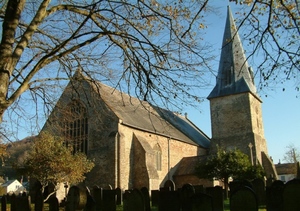Work in progress, please pay us another visit soon.
The village of Braunton in Devon lies just a few miles from the sea, its sand dunes and the Taw-Torridge Estuary make it a lovely holiday location and a
pleasant place to live. Although considered by most of those living there to be a village, Braunton, with over seven thousand inhabitants is actually the size of
a small town. You can walk on Braunton Burrows, a designated biosphere reserve and the first in the country to have gained this title, and along the South West
Coastal Path. South of the village is the River Taw that has made its way northwards from its origins on Dartmoor, its path changing direction until it reaches
Heanton Punchardon and from there it flows south-west, diverted from its path by the aforementioned massive sand dunes of Braunton Burrows before it
joins with the River Torridge, to form a tidal estuary that takes its name from both rivers.
From there it joins the Atlantic Ocean.
pleasant place to live. Although considered by most of those living there to be a village, Braunton, with over seven thousand inhabitants is actually the size of
a small town. You can walk on Braunton Burrows, a designated biosphere reserve and the first in the country to have gained this title, and along the South West
Coastal Path. South of the village is the River Taw that has made its way northwards from its origins on Dartmoor, its path changing direction until it reaches
Heanton Punchardon and from there it flows south-west, diverted from its path by the aforementioned massive sand dunes of Braunton Burrows before it
joins with the River Torridge, to form a tidal estuary that takes its name from both rivers.
From there it joins the Atlantic Ocean.
As with many of the towns and villages of the West Country, Braunton’s roots lie in the culture of the Celts. Like other West Country saints such as
Gildas and Pyran, Brannock, a Gaelic priest in the household of King Brenckock founded a monastery and a new community on the site of a Saxon church.
Brannock, it is said, landed on Saunton Sands at the mouth of the River Taw in the sixth century, a time when the Welsh were raiding the Dumnonii people
with the aim to conquer and spread the word of God. By the thirteenth century, Braunton had a new church, named after its founder, and around which
the village of Braunton grew.
Gildas and Pyran, Brannock, a Gaelic priest in the household of King Brenckock founded a monastery and a new community on the site of a Saxon church.
Brannock, it is said, landed on Saunton Sands at the mouth of the River Taw in the sixth century, a time when the Welsh were raiding the Dumnonii people
with the aim to conquer and spread the word of God. By the thirteenth century, Braunton had a new church, named after its founder, and around which
the village of Braunton grew.
If you stand with your back to St Brannock's and look over the estuary you will see the lush green fields that lie between the village of Northam and Appledore
the site, it has been claimed, of what could only be called a rematch, in 1069, of the Battle of Hastings, between the sons of
King Harold and the Norman conquerors. Author Nick Arnold has suggested that more than 3,000 people died in this clash, where
“64 longships crammed with armed men led by Godwine and Edmund arrived at Appledore on 26 June 1069.”
This army, which arrived from Ireland, met a fighting force made up of Normans, Bretons and English.
the site, it has been claimed, of what could only be called a rematch, in 1069, of the Battle of Hastings, between the sons of
King Harold and the Norman conquerors. Author Nick Arnold has suggested that more than 3,000 people died in this clash, where
“64 longships crammed with armed men led by Godwine and Edmund arrived at Appledore on 26 June 1069.”
This army, which arrived from Ireland, met a fighting force made up of Normans, Bretons and English.
A mighty battle indeed! Research has not taken me back to the mid 11th century, so I can only guess if my ancestors from Braunton took part or kept their
distance while this encounter was taking place. I believe my Bustaine ancestors, including the local families from Heanton Punchardon and Wrafton who
they married into, were local to this area from that time.
Poet Laureate Sir John Betjeman in his Best British Churches, states that St Brannock was "almost certainly" buried beneath the high altar of Braunton's church,
and if this is true then my ancestors are in good company, for nearly all members of Bustaine family were baptised, married and buried in this church
over a period of three hundred years. So, when my 13th great grandfather Walter Bustaine died in 1551, historian and antiquarian William Camden was born and
John Dudley, the Duke of Northumberland was planning to place his daughter in law, Lady Jane Grey on the throne of England.
distance while this encounter was taking place. I believe my Bustaine ancestors, including the local families from Heanton Punchardon and Wrafton who
they married into, were local to this area from that time.
Poet Laureate Sir John Betjeman in his Best British Churches, states that St Brannock was "almost certainly" buried beneath the high altar of Braunton's church,
and if this is true then my ancestors are in good company, for nearly all members of Bustaine family were baptised, married and buried in this church
over a period of three hundred years. So, when my 13th great grandfather Walter Bustaine died in 1551, historian and antiquarian William Camden was born and
John Dudley, the Duke of Northumberland was planning to place his daughter in law, Lady Jane Grey on the throne of England.



